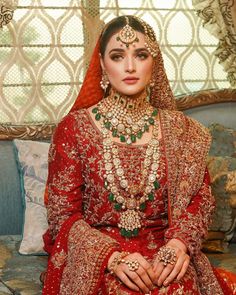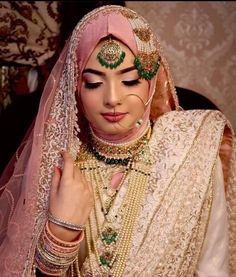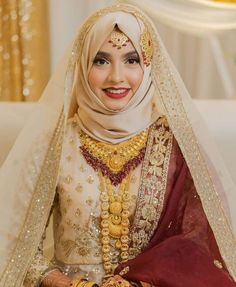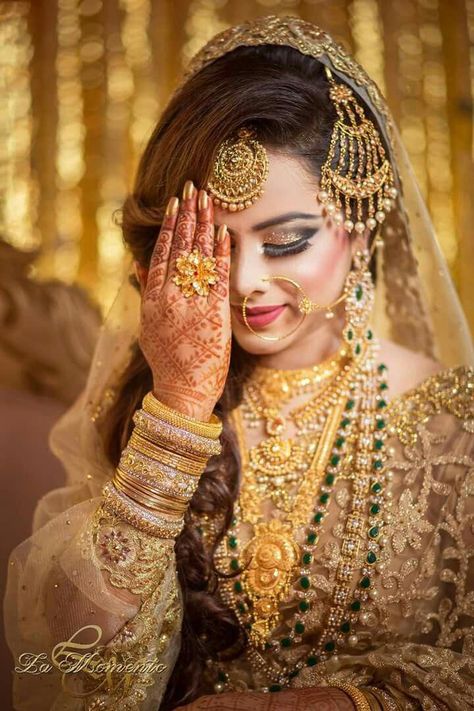North Indian Muslim Bridal
The wedding ceremony in North Indian Muslim culture is a beautiful amalgamation of tradition, customs, and rituals that reflect the rich heritage and cultural diversity of the region. From vibrant pre-wedding celebrations to solemn wedding rituals and post-wedding traditions, every aspect of the North Indian Muslim bridal journey is steeped in history and symbolism. In this class note, we will explore the intricate details of North Indian Muslim bridal customs, highlighting the elegance and significance of each tradition.

Pre-Wedding Rituals:
- Mangni (Engagement): The journey of a North Indian Muslim bride typically begins with the mangni or engagement ceremony, where the families of the bride and groom formally announce their intention to marry. It is a joyous occasion marked by the exchange of rings, gifts, and blessings, symbolizing the union of two families.
- Mehendi Ceremony: The mehendi or henna ceremony is a festive pre-wedding ritual where intricate designs are applied to the bride’s hands and feet with henna paste. It is a symbol of beauty, adornment, and celebration, with family and friends coming together to sing, dance, and share in the joy of the upcoming wedding.
- Manjha Ceremony (Haldi Ceremony): The manjha or haldi ceremony is a traditional pre-wedding ritual where turmeric paste is applied to the bride’s and groom’s bodies to cleanse, purify, and beautify their skin. It is believed to ward off evil spirits, bless the couple with good fortune, and prepare them for the wedding festivities ahead.

Wedding Attire:
- Bridal Lehenga: The traditional bridal attire for North Indian Muslim brides is the bridal lehenga, a long skirt paired with a matching blouse and dupatta (scarf). The lehenga is typically embellished with intricate embroidery, zari work, and embellishments such as sequins, beads, and stones, creating a stunning and opulent look for the bride.
- Jewelry: North Indian Muslim brides adorn themselves with exquisite jewelry, including gold necklaces, earrings, bangles, and nose rings. The jewelry is often passed down through generations and holds sentimental value, symbolizing love, commitment, and family heritage.
- Dupatta: The dupatta or scarf is an essential part of the bridal ensemble, draped over the head or shoulders to complete the look. It is often embellished with embroidery, lace, or tassels, adding a touch of elegance and sophistication to the bride’s attire.
Wedding Rituals:
- Nikah Ceremony: The nikah ceremony is the central ritual of a North Indian Muslim wedding, where the bride and groom solemnize their marriage vows in the presence of a qazi (Islamic scholar) and witnesses. The groom offers a mehr (dowry) to the bride as a symbol of his commitment and responsibility, and the marriage contract is signed by the couple and their families.
- Arusi Ceremony: The arusi ceremony is a traditional custom where the bride’s family gifts the groom with items such as clothing, jewelry, and household goods as a gesture of welcome and acceptance into the family. It is a symbolic exchange of gifts and blessings, strengthening the bond between the two families.
- Walima Reception: The walima reception is a celebratory feast hosted by the groom’s family to mark the union of the bride and groom. It is an occasion for family, friends, and community members to come together, share in the joy of the newlyweds, and partake in delicious food, music, and merriment.

Post-Wedding Traditions:
- Rukhsat Ceremony: The rukhsat ceremony is an emotional moment where the bride bids farewell to her family and leaves her parental home to start a new life with her husband. It is a tearful yet joyous occasion filled with blessings, prayers, and well-wishes for the bride’s happiness and prosperity in her new home.
- Suhag Raat (Wedding Night): The suhag raat is the wedding night, where the bride and groom consummate their marriage and begin their journey together as husband and wife. It is a private and intimate moment shared between the newlyweds, marked by love, affection, and anticipation for the future.
Conclusion: The North Indian Muslim bridal journey is a tapestry of tradition, elegance, and cultural heritage, woven with rituals, attire, and customs that have been passed down through generations. From the vibrant colors of the bridal lehenga to the solemnity of the nikah ceremony, each aspect of the wedding celebration is imbued with meaning, symbolism, and tradition. Through this class note, we have explored the journey of a North Indian Muslim bride, from pre-wedding rituals to post-wedding traditions, celebrating the beauty and elegance of this cherished cultural heritage.


